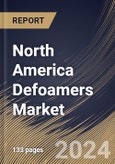Defoamers find applications in pharmaceutical formulations, cosmetics, and personal care products to prevent foam formation during mixing, blending, and filling processes. They help ensure product stability, consistency, and packaging integrity. Defoamers control foam formation in dye baths, fabric softeners, and finishing agents in textile manufacturing processes such as dyeing, printing, and finishing.
Additionally, these are employed in the oil and gas industry to control foam formation in drilling, fracturing, and production processes. They help maintain drilling efficiency, prevent blowouts, and enhance well productivity.
Similarly, Mexico's growing food and beverage sector significantly influences the demand for it by increasing production volumes and emphasizing foam control in processing and packaging operations. According to the United States Department of Agriculture, with an average yearly growth rate of 4.3 percent and a projected GDP contribution to Mexico's economy of $39.4 billion by 2020, the food processing industry is one of the most dynamic in the country. Hence, the expansion of the cosmetics industry and the growing food and beverages sector in the region is propelling the market's growth.
The US market dominated the North America Defoamers Market by Country in 2022, and would continue to be a dominant market till 2030; thereby, achieving a market value of $763.6 million by 2030. The Canada market would register a CAGR of 6.9% during (2023 - 2030). Additionally, The Mexico market is showcasing a CAGR of 6% during (2023 - 2030).
Based on Product, the market is segmented into Silicone-based, Water-based, Oil-based, and Others. Based on Application, the market is segmented into Pulp & Paper, Paints, Coatings, & Inks, Adhesives & Sealants, Agriculture, Personal Care & Cosmetics, Food & Beverages, Household and Industrial/Institutional Cleaning, Water Treatment, and Others. Based on countries, the market is segmented into U.S., Mexico, Canada, and Rest of North America.
List of Key Companies Profiled
- Kemira Oyj
- Air Products and Chemicals, Inc.
- Ashland Inc.
- The Dow Chemical Company
- Evonik Industries AG (RAG-Stiftung)
- Wacker Chemie AG
- BASF SE
- Elementis PLC
- Clariant AG
- Eastman Chemical Company
Market Report Segmentation
By Product (Volume, Kilo Tonnes, USD Billion, 2019-2030)- Silicone-based
- Water-based
- Oil-based
- Others
- Pulp & Paper
- Paints, Coatings, & Inks
- Adhesives & Sealants
- Agriculture
- Personal Care & Cosmetics
- Food & Beverages
- Household and Industrial/Institutional Cleaning
- Water Treatment
- Others
- US
- Canada
- Mexico
- Rest of North America
Table of Contents
Companies Mentioned
- Kemira Oyj
- Air Products and Chemicals, Inc.
- Ashland Inc.
- The Dow Chemical Company
- Evonik Industries AG (RAG-Stiftung)
- Wacker Chemie AG
- BASF SE
- Elementis PLC
- Clariant AG
- Eastman Chemical Company
Methodology

LOADING...








